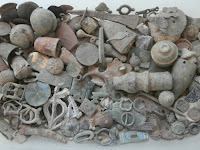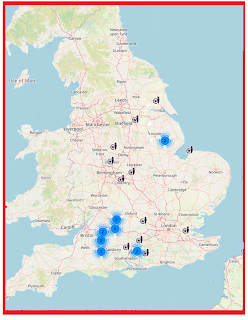On a metal detecting forum near you (MDF)
they are trying various measures to boost traffic, to maintain sponsor revenue. So, they are doing quizzes and 'show and tell' at the moment. One of the latter was "show us your counterfeit coins" and one otherwise anonymous "Adam" posted up a picture of "his" Edward I. This was followed by others posting up various coins (some of them demonstrating that they'd not really understood the question). But I thought the fake was highly interesting, for a number of reasons that escaped the short attention span of forum members. I'm not going to put a photo here, but this was a highly illiterate and rough copy, it is a shame that it was being shown on a closed members-only metal detecting forum, but has not yet been responsibly recorded on the PAS database. What was intriguing was that the silver plating had been worn off the copper alloy (? the "owner" did not say) base and the coin had been heavily circulated. The finder said nothing about context and meaning of its current state, just presented the object and bathed in the kudos of having hoiked it from the ground. Like his fellow artefact hunters he was interested in just the object. The PAS calls such people "citizen archaeologists", and if that were so, the meaning and context would be more important.
Was this coin heavily circulated because the majority of the users were unable to tell that the writing on it was illiterate and just assumed that the coin they had been given by its previous user was an official issue? Or was it heavily circulated because it had passed quickly from hand to hand (for example in transactions conducted with strangers in the dusk) precisely because each user when they took a closer look realised that they'd been cheated and they were landed with a dangerous fake coin?
If this coin had been recorded on the PAS database, it would have added to the information that it might supply on this aspect of medieval life. Most PAS-recorded finds were made by artefact hunters ripping them out of the archaeological record in rural areas. Can, therefore these 'data' be used to say something about coin circulation in Medieval rural contexts? Since the tekkies were so blindly concerned with "
whattyougot?" (
yeah) perhaps we can look at the question here.
There are at least three problems with these 'data':
- first most things hoiked by artefact hunters do not get recorded in the PAS 'database' and what is there is by no means representative.
- the PAS search engine needs to be able to pick them out of the large mass of other stuff, and thirdly,
- the nature of the item needs to be recognised by the recorder.
MDF member metal detecting Adam's coin seems not to be in the database (and he made no effort to give a link to where other members could look it up there). If we look at the Revised Artefact Erosion Counter, we see that the current figure at eight in the morning
is: 8,033,032 objects. The PAS boasts at the same time that in their 'database' they have
1,493,237 objects within 954,447 records. So there is a massive shortfall in recording. Massive.
That is four in five objects are not recorded (and if we look at it in terms of records, it is seven in eight !). The unrecorded pieces being shown off on the metal detecting forum behind those closed doors are the rule, not an exception.
There are problems that the PAS database is inconsistent in terminology, some are called forgeries (which is
the wrong term anyway the term should be fakes) and others call them counterfeits, so anyone wanting to examine this issue has to juggle different groups of inconsistent search results. I wanted to look at the coins from the period of 1185-1307 (the monetisation of the English economy) so these are teh datasets I was looking at:
counterfeit,
forgeries,
fakes.
Thirdly one wonders about numismatic expertise when mapping them shows a notable cluster in just one county (Wiltshire) and a much lighter scatter elsewhere in the south and east. This would be less of a problem than it is if all the coins in question had been photographed and properly described by the recorders before they were handed back to the finder. Not all coins of Henry II and Edward I are however given as much attention as rarer issues to which different standards are applied (and it should not be like that).
Forgeries, 48 items
Ruler/issuer:
Henry III of England (18)
Edward I of England (8)
Henry II of England (3), Henry II - Henry III (1), Richard I of England (2), John of England (1), Alexander III of Scotland (1),
Continental sterling imitation Guy of Dampierre (1)
Denomination:
Penny (30)
Cut halfpenny (12)
Cut farthing (1)
Halfpenny (1)
Uncertain (1)
Nominal Mint:
Canterbury (7)
London (4) York (4)
Dublin (1)
Exeter (1)
Namur (1)
Winchester (1)
Material:
Silver (31)
Copper alloy (12)
Base Silver (5).
Fakes (zero examples)
Counterfeits: five examples
Ruler/issuer:
Henry III of England (4)
Edward I of England (1)
Denomination:
Penny (4)
Nominal mint:
Canterbury (2)
London (1)
Material:
Copper alloy (2)
Silver (3)
One of them came from a hoard
YORYM-755D34 ('Based on class 3c Nicole Canterbury
hENRICVS REX III, pellets by hair 1.3 (17)
NIC OLE ON C[A]N - not individually illustrated in the skimpy description), this is the 'Asbourne Area' (Derbyshire Dales)
Most of the entries are unverified by the finds specialists.
It is difficult to see what can be done with these data. Only one coin recorded made it into a hoard - but then nothing is known of the context of deposition of this group of coins, so that does not tell us much. Perhaps the die links would be informative if there were more than seven of the type of Henry II, 22 of Henry III and nine of Edward I (plus the one we know MDF member Adam has secreted away). The mapping search results facility is even crappier than usual, totally inconsistent. Here, above, is what I was able to do manually, singularly uninformative, the general distribution matche that of deposits of coins of the same period in general, so it remains unclear what 'mapping them' (the only analytical tool offered by PAS to its users) will achieve. In short, once again, when you look at the "artefact hunters are supplying useful archaeological information, so leave them alone" paradigm, it turns out to have no real basis in fact. Metal detctorists display their unrecorded trophy finds to each other behind closed doors, some occasionaly find their way to a museum, others onto eBay. Archaeologists look on smiling blithely and tell us that this is a "good thing"... but in fact it is just senseless and unproductive damage.



































